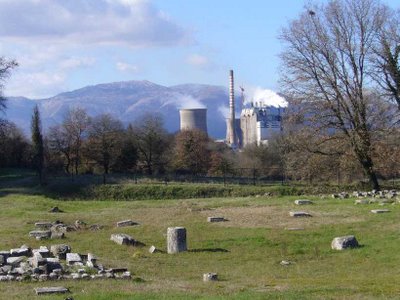Peloponnese Day 6: Arkadia

As seen from the top of Mt. Lykaion, smoke emanating from the power plant in the Tripolis plain. Mt. Lykaion.
Mt. Lykaion.
Brief excavations at the turn of the 20th century by Greek archaeologists. Sanctuary of Zeus sacred to Arkadians. Whole mountain was sacred, Zeus’ birthplace. Stadium and hippodrome. At top, sanctuary of Pan; ash altar – burnt stones, small animal bones, C5-4 pottery, Aiginetan coins, bronze tripods. Human sacrifice here? 30m diameter altar. Found rooftiles, bronze figurines, but no building. Later (1909) excavated in lower sanctuary. Vanderpool recorded some inscriptions, saw four starting blocks for stadium in situ. We can see one of them. Late C7 activity on top. Lower: C4.
Pausanias: “games used to be held here.” Site was unexplored til 1999, David Romano came here. Only place where we have a preserved hippodrome on Greek mainland. Started test trenches this year, and a survey. Found packed earth floor of stadium/hippodrome. Started Lykaion Games in 1960’s, brought in tons of gravel which now distorts our orientation. Xenon, longer stoa, steps, drain (modern) – spring was an ancient source for the sanctuary. Rectangular structure: late antique building, not published. C4 bath with bathtubs. In the next few years, we should learn a LOT more about this site.
Lykaios < wolf – wolf-stories with Zeus. A man (Lykaios) tried to fool Zeus, killed a slave and offered the meat to Zeus; Zeus changed him into a wolf. Romano has collected all the sources on his website. Allusions of human sacrifice here. You can’t see your shadow up on the ash altar.
 There were wild flowers everywhere, especially cyclamen, at Lykosoura.
There were wild flowers everywhere, especially cyclamen, at Lykosoura. Seats in the theater at Megalopolis.
Seats in the theater at Megalopolis.
-Huge city wall, designed to include fields.
-Divided by Helison River. Theater and Thersileion are on one side; other side: agora with stoa, civic center, sanctuary of Zeus Soter.
-Thersileion: in ruins at Pausanias time, excavated 1891-1893 by Loring (British School). Designed for many, many people, maybe 10,000.
-Theater
-Building under pile of gravel – rectangular structure and C2 roof tiles: skenotheke.
-Did the theater therefore have a movable stage? Was it originally so? Thersileion is very close to the theater. Massive colonnaded porch faced the theater. Maybe the Thersileion was used as a backdrop for the theater.
-Bulla says: theater was for assembly, religious performances, not dramatic performances. He may be prejudiced against rural peoples’ ability to have real theater.
What’s here: columns in radiating lines (protects sight lines). Later, 7 columns were added to protect the structure; early excavators were puzzled by Thersileion’s orientation – opening to theater. Germans excavated here 2000-2003 and say that it’s constructed with the porch in mind, as a planned part of the building. Because they’re oriented to each other, maybe built Thersileion and Theater as a unit, OR the later one was built to orient with it. No stratographic material is left. New excavators look at the stratigraphy from Agora. They use the 2 complexes as comparanda for each other – clamps, chisel markings, shapes of blocks, architecture generally. Conclusion: original theater and skenotheke built as one unit. Believes the Thersileion was constructed first, along with the so-called Stoa of Philip.
Second generation: theater, skenotheke, and Meropolis Stoa. Late C4 (or end of C4) BC. Alternating leader and stretcher courses, diamond shaped chisel rustication (deliberate rough look on stone).
Third generation: skene frons. This blocks the skenotheke, which was then no longer used. Presumably the colonnade of Thersileion was the backdrop. Skene frons is only head-high.
222 BC – destruction by a Spartan king, Kleomenes III. Razes and burns the city. Cause of Thersileion’s destructions that Pausanias sees in C2 AD. Germans doubt this (i.e., that it wasnever rebuilt). Evidence suggests a leading citizen, Philopoemon, contributed funds to rebuld stuff damaged by Kleomenes. This is the phase when the 7 columns are added – matches to a dated stoa in the agora, with rooftiles with Philopemon’s name on it. The article is very new, should be quite controversial.
Back of honorary seats in theater – there is an inscription that identifies it with a C3 Olympic victor.
340’s: founding of the Thersileion
Late C4: Theater
Philopoemon phase: fixing the theater.
The theater is not really built into the hill. It comes out very far, and uses military fortifications in retaining wall. The earth fill was softer The temple of Despoina at Lykosoura.
The temple of Despoina at Lykosoura.
 I took this photo in January, actually, but this is the power plant as seen from the Thersileion of Megalopolis.
I took this photo in January, actually, but this is the power plant as seen from the Thersileion of Megalopolis. The Stoa of Philip (V?) at Megalopolis Agora:
The Stoa of Philip (V?) at Megalopolis Agora:
C4-C5 AD: major destruction, C6AD: private houses built.
Old Bouleuterion on N (DEH) side. Also a gymnasion somewhere.
Stoa of Philip (standing) is 2nd largest stoa in Greece. Germans did anastylosis. Leake saw a lot of columns sticking up. Could see cavea of theater, some seats (later were robbed away).
DEH: lignite coal plant. Lots of lignite here. Should close by 2022.

0 Comments:
Δημοσίευση σχολίου
<< Home